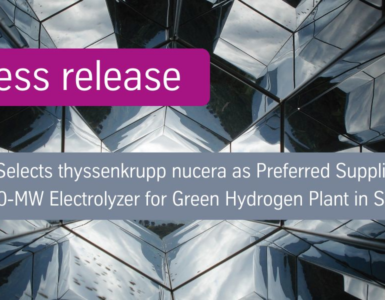Germany, Denmark, Netherlands and Belgium sign €135 billion offshore wind pact, tap new potential for green hydrogen.
[Euractiv] Heads of government from the North Sea countries met in the Danish town of Esbjerg to sign a cooperation agreement on offshore wind development and green hydrogen. They will target at least 65 GW by 2030 and 150 GW by 2050.In a joint declaration, the North Sea countries state their intention of becoming the “Green Power Plant of Europe”.
The North Sea’s reliable winds, shallow waters, and proximity to industrial centres that are big consumers of electricity, makes it a perfect fit for the installation of offshore wind farms.
🔥 What about we co-host a webinar? Let's educate, captivate, and convert the hydrogen economy!
Hydrogen Central is the global go-to online magazine for the hydrogen economy, we can help you host impactful webinars that become a global reference on your topic and are an evergreen source of leads. Click here to request more details
Robert Habeck, Germany’s Vice-Chancellor, said:
Today’s agreement by the energy ministers is an important milestone in cross-border cooperation. It is the basis for the first real European power plants that also generate electricity from renewable energies.
“Together with our partner countries, we can expand offshore wind energy in the North Sea region even faster and more efficiently and tap new potential for green hydrogen,” he said, adding that this would “further reduce our dependence on gas imports.”
The agreement aims for a tenfold increase in offshore wind power capacity in the region, with total investments from the private sector expected to reach €135 billion. In the end, this figure could be even higher, as the European Commission estimated a total of €800 billion in offshore energy investment was necessary to reach the EU’s 2050 target.
Olaf Scholz, Germany’s Chancellor, who is former mayor of Hamburg, a North Sea shipping hub, said:
Using the wind, using the North Sea has a long tradition in our countries.
Offshore wind no longer rely on subsidies and are getting “cheaper and cheaper,” he added, saying that now is the “time for industrialisation”.
The ability to build these projects without public support makes them particularly attractive to policymakers.
Mark Rutte, the Dutch prime minister, said:
I’m so happy that some of these wind farms are now being developed public money being involved.
“We are writing European history!” tweeted Brian Vad Mathiesen, a renewable energy researcher at Denmark’s Aalborg University. The agreement, he added, will provide power for more than 200 million households.
At the same time, the four countries want to intensify cooperation in the production of “green” hydrogen from renewable electricity, with plans to expand related infrastructure in the region.
Green hydrogen, a rare premium commodity, is highly coveted by steelmakers looking to produce carbon-neutral steel.
“There is a real boom in demand for green hydrogen in industry,” said Habeck’s economy and climate ministry on Tuesday (17 May).
The North Sea wind farms should play a major role in supplying sufficient hydrogen, policymakers says.
“By harvesting the abundant offshore wind resources of the North Sea, we can also pave the way for the hydrogen economy. Offshore wind power frequently generates more electricity than is needed,” wrote Energy Commissioner Kadri Simson and Danish Energy Minister Dan Jørgensen in an op-ed for EURACTIV.
Speeding up the renewable rollout
The four countries also highlighted the importance of “speeding up” permitting procedures at EU level, in line with the European Commission’s ‘REPowerEU’ plan presented yesterday.
To accelerate deployment, the EU executive wants to make permitting procedures simpler, with new wind and solar projects being declared a matter of “overriding public interest”, and ‘go-to’ areas introduced at the national level in zones with low environmental risk.
With Germany, Denmark, the Netherlands and Belgium throwing their weight behind faster permitting, the North Sea looks like an ideal candidate to become the EU’s first “go-to” zone for renewables.
Ursula von der Leyen, Commission President during the meeting in Esbjerg, said:
Nowadays we have permitting times between six and nine years.
In “go-to” areas, those would be shortened to one year.
“This would be one here, in Denmark” and it would be “of utmost importance to the industry,” she added.
Germany, Denmark, Netherlands and Belgium sign €135 billion offshore wind pact, source








